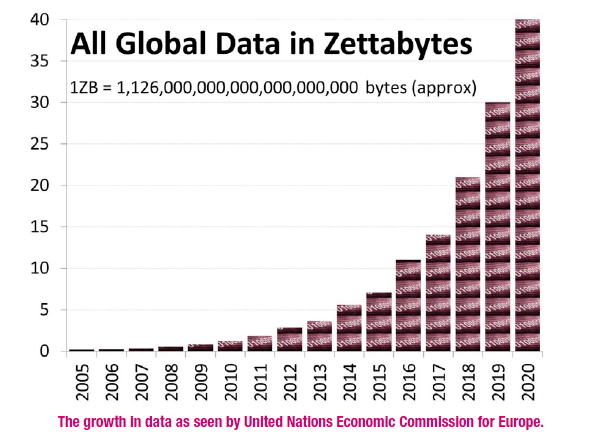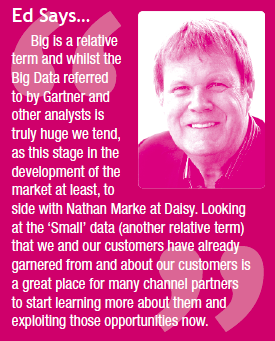
We all recognise that the amount of data being created is growing at a prenominal rate but the concept of ‘Big Data’ is throwing up as many opportunities as it is difficulties. Key amongst these is having the ability to harvest that data and use it to make smarter decisions.
According to the Cisco Visual Networking Index Global Forecast and Service Adoption for 2013 to 2018, global Internet Protocol (IP) traffic will increase nearly three-fold over the next four years due to more Internet users and devices, faster broadband speeds and more video viewing. Global IP traffic for fixed and mobile connections is expected to reach an annual run rate of 1.6 zettabytes – more than one and a half trillion gigabytes per year by 2018. The projected annual IP traffic for 2018 will be greater than all IP traffic that has been generated globally from 1984 – 2013 (1.3 zettabytes).
To place the recent FIFA World Cup in context, global IP traffic is expected to reach 132 exabytes per month by 2018, which is the equivalent to:
• 8.8 billion screens streaming the FIFA World Cup final game in Ultra-HD/4K at the same time.
• 5.5 billion people binge-watching ‘Game of Thrones’ Season 4 via video-on-demand in HD or 1.5 billion watching in Ultra-HD/4K.
• The season 3 premier of ‘House of Cards’ streaming in Ultra-HD/4K on 24 billion screens at the same time.
• 940 quadrillion text messages.
• 4.5 trillion YouTube clips.
In 2012, Gartner updated its definition for Big Data as follows’ “Big data is high volume, high velocity, and/or high variety information assets that require new forms of processing to enable enhanced decision making, insight discovery and process optimisation.”
Commenting on those three key values, Volume, Velocity and Variety, Mark Curtis-Wood, Head of Network Services at Nimans says that analysis of information is one of the biggest elements of Big Data.
“It’s becoming more and more critical with Machine to Machine (M2M) one of the key driving factors. Profiles and behaviour of customers can build up valuable buying and lifestyle patterns.
First of all channel partners need to capture information and join it up, not just one dimensionally but in a three or four dimensional way, something that’s potent and powerful. The Internet of Things and M2M are going to drive more information. It could be a SIM card in a washing machine or a fridge that then analyses what food is being consumed and when. This could lead to special offers being sent to the consumer. As more information moves around the globe there’s more opportunity to collect it, pool it, monetise it, present it in a compelling way and sell it to businesses that can use it.
As this process speeds up the demand for Big Data increases as well. The Volume of data is going to come from people accessing faster connectivity and deployment. Velocity will come from speed of 4G etc. and Variety could come from all sorts of areas. Maybe a smart car where the same piece of information could be sold to four different parties… the manufacturer, the car dealer, the driver and perhaps another member of their family who is the insurance holder.”
Nathan Marke, Chief Technology Officer at Daisy Group, says that there is no doubt that digital is transforming business in every sector and the cornerstone of a successful strategy is the ability to control, understand and exploit data, whether that be to target products at customers more accurately, improve customer service or drive supply chain efficiencies.
“But while big data is the buzz phrase of the moment, it can actually be quite misleading. In fact, I believe small data, is just as, if not more, important. After all, every business is sitting on a mountain of it.
Mastering data and how to use it should begin within your own organisation and with your own data. If you can control this and achieve a few
key wins through exploiting this knowledge, you can show your business the value of data and lay the foundations for how to understand and then exploit the wider big data opportunity, correlating big datasets with your own to create value.
A starting point has to be recognising the opportunity and therefore its intrinsic value, then creating an owner within your business, who has full responsibility for the function.
In a world where so many similar products and services exist, it is becoming harder and harder to differentiate. So by understanding how to exploit data, a company with an inferior product offering has greater potential for success. Existing or prospective customers can only buy what they are aware of, so if you hit them with the right thing at the right time and in the right style you will win, even if your product is inferior.”
 Volume Perspective
Volume Perspective
Many observers say that the biggest issue with big data is not the huge volume of data to be stored, or the ability to structure it in a way that it can be digested by business, it is being able to reliably access it at a speed that meets the end user’s expectations.
According to Lance Spencer, Director of Connectivity Services at TalkTalk Business, today, those end user expectations are very high, with even the humble residential user having access to high quality, high speed connectivity.
“So having dependable access in the office, sized appropriately for the number and type of users in the office, is crucial. Most business premises are either already on, or are moving to Ethernet connectivity, where 10Mbps symmetrical connectivity is the absolute minimum, with many offices connecting with 100 Mbps or even Gigabit connectivity.”
However, Michiel von der Crone, Field Advisory Services Team Director, EMEA, at CommVault says that while inexpensive cloud-based storage may be enabling some big data strategies the reality is that while it is feasible to store all the data in the cloud, even with fast connections retrieving that 5Tb of data from the cloud back into the organisation would take an unfeasibly long time.
“Furthermore, cloud costs are increasing, especially as organisations add more data; and even cheaper outsourced tape backup options still incur escalating power and IT management costs. In addition, the impact of unused data sitting on primary storage extends far beyond higher backup costs; time consuming end user access leads to operational inefficiency and raises the risk of non-compliance.”
Channel Opportunities…
Mark Curtis-Wood at Nimans notes there are a number of key criteria to consider… such as where the information is coming from.
“There’s a huge variety of information available around customer behaviour. A lot of this is being carried by the big mobile networks and as people become more mobile this is the type of behaviour that’s being tracked. It may be a regular visit to a coffee shop or a journey to work. The key is how do channel partners get access to that information and secondly how are they going to exploit it and process it in a commercial way to make money by effectively selling back to their customers?
The advantage of dealing with a wholesale provider like us is that we are looking at ways to facilitate this.
The volume of data available is growing all the time, increasingly driven by cloud services. People use CRM which is starting to be integrated onto tablet devices and then there’s 4G. So you’ve got location information tied into sales information and commercial information. This then builds a three dimensional picture of a customer. Many businesses still hold information on traditional spreadsheets that are probably in different parts of a building which means information isn’t joined up so has limited worth. But Big Data allows it to be pulled together and when combined with location information it becomes a lot more powerful and valuable.”
As Nathan Marke at Daisy Group points out, businesses are currently flooded with an abundance of unstructured data from various areas that needs to be controlled in order to affect real business decisions.
“This means we need to be prepared to enable innovation in our businesses and get accustomed to a much faster pace of change.
Big data can be implemented in many ways and for multiple uses including behavioural analytics, customer segmentation, pricing optimisation and detecting and preventing fraud and security threats. At Daisy our internal focus has been on ‘small data’ (i.e. our own) coupled with traditional business insight. We use what we know about our customers through their records and their bills to improve customer services and drive more sales.

“This is just the start of a longer journey as we begin to exploit big data in a much wider sense. Last year we were successful in deploying High Density Wi-Fi for Sports Revolution at Celtic Park. Our Crowd Connect portal allows the football crowd to engage with the Sports Revolution app CelticLIVE, providing content to fans. The system utilises access control and web filtering for security purposes. It also collects permissive data from subscribers enabling Sports Revolution to help Celtic FC understand more about its fan base- ultimately scoping the future for a differentiated stadium experience.
We see our ability to deliver these services to our customers as they progress on their digital journey as a critical objective for Daisy. While global conglomerates like Amazon, Google and Facebook lead the big data game, even the smallest companies can leverage data to be smarter than their bigger competition. Big companies have more problems around focus than small ones and there are plenty of platforms out there that can handle datasets in the cloud and provide outsourced analysis for those wanting to move into a larger play.”
